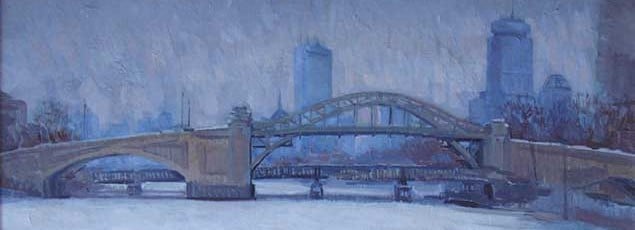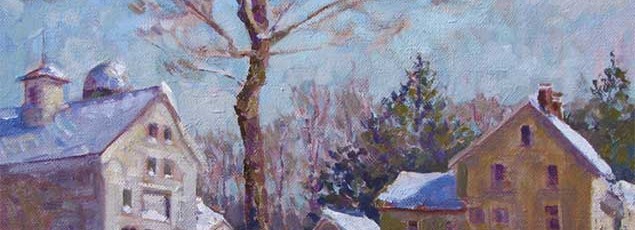After graduating from the Florence Art Academy, Leo became an instructor and subsequently Director of the drawing program for sculptors. He uses traditional materials, his own hand-ground paints, canvases and oils.
You may have heard, the Boston area is getting much more snow than usual this year. People are glum – we’ve had a ton of snow and not a lot of blue skies. Getting out and painting keeps me looking forward to each storm.
The blanket of snow always looks beautiful with bright sunshine, but I’ll even paint in the snow at times. If its wet out, trying to keep your brushes dry is helpful.
A wet brush looses its snap, and can ruin them if you use them to scrub on the canvas. After there’s paint on them it matters less.
Oils eventually freeze. Painting at low temperatures, your paints will start to stiffen up noticeably, flowing more like wet sand than butter. You’d think you could dip into your medium more often, but undiluted oil or more viscous mediums thicken up until they are nearly useless.
The blanket of snow always looks beautiful with bright sunshine, but I’ll even paint in the snow at times.
The good news is, spirits do not freeze. To keep the paint mobile I remember reading that painters would mix a drop or two of kerosene (not a spirit that we would use these days) into each blob of paint on their palette before going out. I’ve tried it, but I find its easier to just keep a much more diluted medium in the winter (less than one part oil to spirit) and often, paint with mineral spirit or turpentine alone. At below freezing temps that will almost work like a medium normally does.
After figuring out a system that works, winter has become my favourite season to paint outdoors.
Images courtesy of Leo Mancini-Hresko.
See more of Leo’s work at: www.leomancinihresko.com
Or follow him on Facebook: Leo Mancini-Hresko


